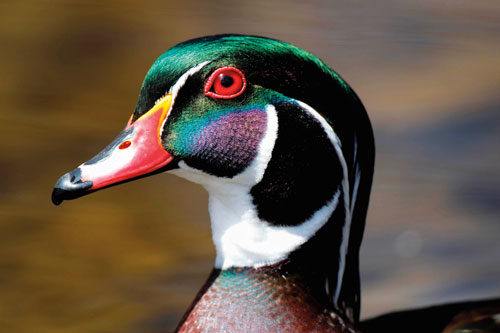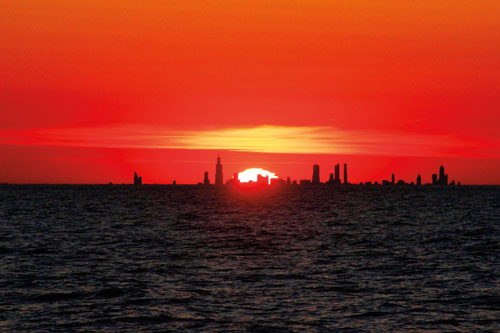About Outdoor Indiana
Outdoor Indiana, the state's premier magazine, delivers the wonders of the Hoosier outdoors to subscribers' homes and offices six times a year in 48 pages of vibrant color. For the best of state parks, lakes, wildlife, forests, trails, hunting, fishing, wildflowers and outdoorsy people, plus inside information from DNR experts, subscribe for $15 per year or $28 for two years. Follow the magazine staff on Facebook.
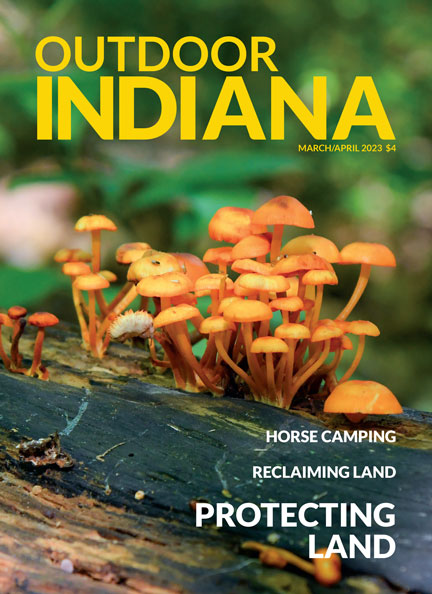
A dense cluster of orange mycena grows on a decaying tree at Moraine Nature Preserve, a destination that was expanded last year.
Photo by Brent Drinkut.
Featured Stories
- From the director
THANK YOU, LAND TRUSTS

DNR Director Dan Bortner
Welcome! In this issue we look at the successes of the President Benjamin Harrison Conservation Trust, an enhanced version of the Indiana Heritage Trust. We also introduce the Next Level Conservation Trust and document the final projects of the Bicentennial Nature Trust. This also is the second issue featuring a land trust page.
That’s a lot of trusts. Keeping track of each one’s role is challenging. That’s where the Indiana Land Protection Alliance (ILPA) comes in. Established in 2000, it’s the statewide association of land trusts, conservation organizations, and conservation minded individuals advancing land conservation for public benefit. Its mission is to increase the pace and quality of land protection in Indiana by enhancing the capacity of our land conservation community.
Through ILPA, the land trusts you read about in OI learn from each other and coordinate their efforts.
In 2018, ILPA received a grant from another type of trust, the Nina Mason Pulliam Charitable Trust, to hire an executive director. Current executive director Andrea Huntington, fourth from the left above, hosted an ILPA December celebration of the 30th anniversary of the Environmental License Plate, where I had the honor of speaking.
Collectively, land trusts in Indiana have protected more than 158,000 acres. As a Hoosier who grew up exploring the hills and hollers of southern Indiana, that has great meaning for me, as it should for anyone who reads this magazine, one I’ve enjoyed since childhood.
- RIDERS (and campers) UP!
DNR offers a variety of horse camping options
By Scott Roberts, OI Staff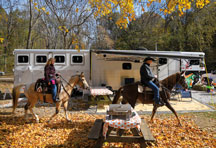
Carl Smith and Susan Johnson head out from their campsite at Brown County State Park for a long trail ride. Photo by Brent Drinkut.
Riding horses is therapy to Susan Johnson. The Nashville resident loves traversing the state’s horse trails because they allow her to find places she can’t get to on foot. Along the way she’ll talk to her trusty companion, which she says always listens.
“You can tell a horse anything, and when you get a good one you want to ride away from everything and just be together,” she said.
Johnson has ridden since she was 1 1/2. She now owns 19 horses and usually takes two or three trips a year to ride. She introduced boyfriend Carl Smith to the hobby a few years ago. Now, she says, he may be more excited about riding than she is.
Being able to camp with their steeds allows the couple to spend more time on the trails and less driving to them.
Jonella Beale of Delphi likes to explore Indiana’s wealth of equine trails on horseback, too. She typically rides to a specific overlook, preserve, river, or restaurant, and often finds the journey as pleasant as the destination.
Laura Whiteleather of Andrews has also loved horses nearly all her life. She’s owned at least one since 1979. She worked for DNR for 12 years before retiring, and she says the best way for she and her husband to enjoy the outdoors is in a saddle.
“There’s nothing like that bonding between horse and rider in the beauty of Indiana,” Whiteleather said. “We’ve camped and ridden in six other states and to us, Indiana is the best.”
Indiana’s state parks and forests have offered horseback riding since 1929. Turkey Run State Park was the first DNR property to do so, on a trial basis. Demand was so great that the opportunity for horse owners to ride trails expanded to other properties. The increase in activity brought the need for horse campgrounds, which are specifically set aside and designed for horses and their owners. These sites are usually wider than traditional campsites to allow room for a horse trailer and typically have a hitching post.
Like many other outdoor activities, horse camping’s popularity boomed during the height of the COVID-19 pandemic, and interest remains at a peak at the 14 DNR horse campgrounds.
Each of these campgrounds across the state offers unique experiences for horse owners.
To read the rest of this article subscribe to Outdoor Indiana or pick up a copy at one of our state park inns. To subscribe, click here or call (317) 233-3046.
- 50 YEARS OF RECLAMATION
DNR transforms abandoned coal mines
By Scott Roberts, OI staff
Photography by Brent Drinkut, OI staff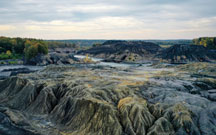
A 180-acre gob pile remains at Abandoned Mine Lands project site 978 in Pike County, which is being reclaimed by the work of the DNR Division of Reclamation.
In 1736, the presence of coal was discovered on the banks of the Wabash River in southern Indiana. Though exactly who found it and where has been lost to history, the benefits and effects of that find are still seen and felt across the region’s landscape.
Today, Indiana is the country’s seventh largest producer of coal, accounting for more than 29.7 million tons or about 4% of the national total, according to the Indiana Coal Council. Although output has declined in recent years due to an increased supply of natural gas, growth of renewable energy sources, and environmental regulations, the state’s mining industry still supports more than 2,500 jobs. That figure adds $750 million to the Hoosier economy, according to the Indiana Center for Coal Technology Research at Purdue University. Indiana was the country’s third largest consumer of coal in 2020, as it provides 58% of Indiana’s electricity according to the Environmental Protection Agency.
Despite constant mining since 1830, Indiana still has more than 17 billion tons of retrievable coal in the ground, which at current consumption rates could last 500 years according to the Indiana Geological and Water Survey (IGWS). This availability continues to make it one of the cheapest and most stable energy resources, even today.
As with most industries, coal production comes with a tradeoff. Open surface mining pits and collapsed underground mines dot much of southwest Indiana. Most of this damage lies in a 17-county area stretching from Vermillion County in the north to Perry County, which borders the Ohio River. These open mines not only make parts of Indiana look like craters on the moon, but also can pose danger to area residents and the environment.
Minerals, especially pyrite, exposed to the air after years underground, can leach acid. For decades, pyrite from mining was discarded in mounds of leftover waste called gob piles after companies washed the coal and determined which pieces of the fossil fuel they wanted to sell. Today’s washing technology has almost eliminated pyrite from the process, but the prior damage done remains.
Also, the steep and uneven terrain from the pits left behind can be hazardous. People walking in these areas can get hurt by tripping and falling. Structures built near these areas can collapse because much of the ground is unstable.
DNR’s Division of Reclamation (DOR) works to solve these issues. “Reclamation” is defined as modifying mined land to an ecologically functional or economically usable state. Since 1982, the division’s Abandoned Mine Land (AML) program has restored more than 1,100 construction sites that encompass approximately 10,000 acres of abandoned coal mines and related impacts from mining.
To read the rest of this article subscribe to Outdoor Indiana or pick up a copy at one of our state park inns. To subscribe, click here or call (317) 233-3046.
- MORE CONSERVATION WINS
Trusts make land protection possible
By Marty Benson, OI staff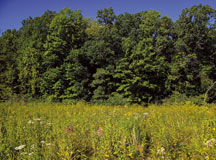
Swamp goldenrod, boneset, and Joe-pye weed are a few of the wildflowers that bloom during fall on the recently protected fen natural community area of Moraine Nature Preserve in Valparaiso. Photo by Brent Drinkut.
Glaciers graced Indiana with many natural wonders, the kettle lakes of the north being the most obvious.
Less prominent recreationally, but no less important ecologically, is the state’s portion of the hilly terrain formed by sediment that mammoth chunks of ice deposited in a U shape near Lake Michigan as they receded north. The land type, no matter where it’s formed, is called a moraine.
Because the Porter County city of Valparaiso occurs within one of the highest elevations of the U shape, this moraine, which also encompasses parts of Wisconsin, Illinois, and Michigan, is called the Valparaiso Moraine. Indiana’s portion also includes parts of Lake and LaPorte counties.
As a demonstration of the area’s conservation importance, 160 acres of the Porter County section was chosen in 1971 as the first nature preserve in the Hoosier state to be owned and managed by the Division of Nature Preserves.
Over the years, Moraine Nature Preserve expanded as land was acquired from willing owners. Entering 2020, the preserve consisted of 870 acres that were officially dedicated by the Natural Resources Commission, and the division owns an additional 70 acres.
Having spent more than a half-century protecting this property, DNR Nature Preserves stays on the lookout for ways to protect more of the moraine, even to serve as a buffer. That’s why, when respective parcels of 14.6 and 11.3 acres along the northern boundary of the existing preserve became available from the York family, the division, through the Benjamin Harrison Conservation Trust (BHCT) and its own Lake Michigan Coastal Program (LMCP) started to explore how to acquire it.
To read the rest of this article subscribe to Outdoor Indiana or pick up a copy at one of our state park inns. To subscribe, click here or call (317) 233-3046.
Reader Photos
Each issue, Outdoor Indiana staff will select reader submitted photos to feature in the magazine. If you would like the chance to be featured, please submit your photo, along with your name and phone number to:
Please, only submit original photography that you have taken. Do not send files over 9 MB in size. JPG format is preferred.
Subscribe to Outdoor Indiana magazine
Visit the Indiana State Parks online store to subscribe. Cost is $15 for a one year subscription (6 issues) or $28 for two years (12 issues).
Donate
Printing and distribution costs for Outdoor Indiana magazine have increased. One way we’re offsetting these costs is through the Friends of Outdoor Indiana Group administered through the Indiana Natural Resources Foundation. Donations to our friends group helps keep our subscription price low and ensures we’ll be around to bring you the best of Indiana’s outdoors for years to come. Donate at the INRF website and include “Friends of Outdoor Indiana” in the “In Honor Of/In Memory Of” line.
Outdoor Indiana
402 W. Washington St., W255-B
Indianapolis, IN 46204
317-233-3046
OIorders@dnr.IN.gov

